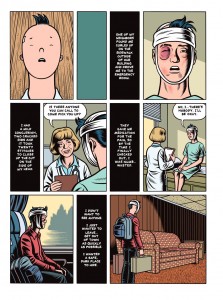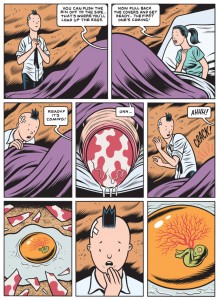Sugar Skull
Reviewed by Andrew Moreton 08-Jan-15
Four years later, the trilogy Charles Burns started in X’ed Out concludes…
 Charles Burns has been around for ages now and as a veteran of Speigleman’s Raw salon enjoys an extremely credible reputation as a serious Graphic Novelist and his longest, most famous piece, Black Hole, is held as something of a classic in art comic circles.
Charles Burns has been around for ages now and as a veteran of Speigleman’s Raw salon enjoys an extremely credible reputation as a serious Graphic Novelist and his longest, most famous piece, Black Hole, is held as something of a classic in art comic circles.
His style is very distinctive and largely unchanged since he first turned up in the eighties – blocky, somewhat mechanical with hard defined lines, inked very heavily -it’s cool and it’s spooky and it’s very static and formal, no speed lines, tight grids, no sound effects.
Black Hole took about a decade to complete and was serialised in pamphlet form over 12 issues. It was a follow-up to a pretty successful sequence of stores called Teen Plague that had run in Raw magazine and a few other places.
 In them teenagers (surprise!) are inflicted with a virus that causes non-glamorous mutations (the X-Men this ain’t). There’s an ominous conflation of sexuality with onset of the disease and it was this idea that Burns took and span out over the course of Black Hole’s 12 issues, to arresting, if ultimately disappointing effect.
In them teenagers (surprise!) are inflicted with a virus that causes non-glamorous mutations (the X-Men this ain’t). There’s an ominous conflation of sexuality with onset of the disease and it was this idea that Burns took and span out over the course of Black Hole’s 12 issues, to arresting, if ultimately disappointing effect.
And sadly Black Hole was disappointing – just like with Lost, Twin Peaks and their ilk – glamorous work that piles promises high at the outset but that sooner, and usually, much, much later, reneges on those promises.
You’ve been there, following a series that’s all portentous symbols, opaque hints and mysteries and the suggestion that if you’re very careful and take a proper amount of notice then all will be revealed. Accept it isn’t. And while the journey itself may be distracting enough, unless the final narrative destination actually exists, well, it’s all gesture and pretention.
After 10 years of hopefully, then dutifully, picking up Black Hole it all ended in a flaccid phut of unresolved storyline and transparent lack of planning…
In late 2010, Jonathan Cape published X’ed Out, first part of a trilogy that ends here in Sugar Skull (the other book is called The Hive). Each volume’s got about 50 pages of story, so a bit longer than a standard pamphlet comic’s 26 or so pages, comes in hardback and are priced accordingly at thirteen quid each. (Not wishing to labour this point – but, – that’s nearly £40 for a 150 pages of comic – and some people think video games are expensive. So, were we Burns-ed again or what?
 Well if it’s innovation you’re after, you’ve come to the wrong place. Burns’ style has barely altered. There’s now colour breaking up the more oppressive weight of his older black and white work and it provides a lighter touch, but the figure work is still stiff and stilted and his faces are blank and inexpressive. The art is dotted with references to Herge, but there’s not hint of the fluidity, movement or character apparent in just about any page of Tintin – sometimes it’s best not to encourage comparisons that you can’t live up to.
Well if it’s innovation you’re after, you’ve come to the wrong place. Burns’ style has barely altered. There’s now colour breaking up the more oppressive weight of his older black and white work and it provides a lighter touch, but the figure work is still stiff and stilted and his faces are blank and inexpressive. The art is dotted with references to Herge, but there’s not hint of the fluidity, movement or character apparent in just about any page of Tintin – sometimes it’s best not to encourage comparisons that you can’t live up to.
 Plotwise, we’ve not come far either. There’s alienated youth, semi-nostalgic and curiously dated pop culture, unexplained surreal body horror and non-linear mysteries. Once again, the promise of a satisfactory resolution keeps you going, (and it has to be said there’s a slightly more coherent attempt at a plot than in Black Hole) but ultimately it seems that Burns is content to offer the suggestion of story worth telling rather than do the hard work of creating something that works.
Plotwise, we’ve not come far either. There’s alienated youth, semi-nostalgic and curiously dated pop culture, unexplained surreal body horror and non-linear mysteries. Once again, the promise of a satisfactory resolution keeps you going, (and it has to be said there’s a slightly more coherent attempt at a plot than in Black Hole) but ultimately it seems that Burns is content to offer the suggestion of story worth telling rather than do the hard work of creating something that works.
A lot of the problem is summed up in a very revealing scene in the trilogy’s first book, where the series’ main protagonist is about to present a reading at a New Wave gig. The piece he’s planning on performing is a William Burroughs style Cut-Up.
(If you don’t know about Burroughs and Gysins experiments with random text generation, it was a technique that involved cutting sentences and words out of books and then arbitrarily recompiling them as new texts.)
Now, while this was no doubt a turning point in Avant Garde literary history, it also produced many many incoherent and pretentious pieces. Cut-up has for a long time been a by-word for lazy art and rightfully the main character is forced to abandon his failing performance. It’s a cogent embedded criticism of this comic – half thought through, trying to look hip and intellectual, but, really, failing to put the concentration and effort into creating a coherent story that works and lives up to its own promises.
I’m not sure how much slack Burns will continue to be given. His comics have a unique look and atmosphere, and there was a time when comics needed to demonstrate that they could do some of the things that Burns can do – but there’s only so much humourless, character free, foreboding anybody can take. Right now his reputation rests on a legacy of stored up kudos but with a style that froze solid in the mid-nineties and shows no sign of thawing.
If he could lighten up a little, think his plots through, create a couple of sympathetic protagonists, draw faster and not publish the results in over priced albums then he might still have something to bring to the table…
Tags: Art Comics, Fantagraphics, Raw